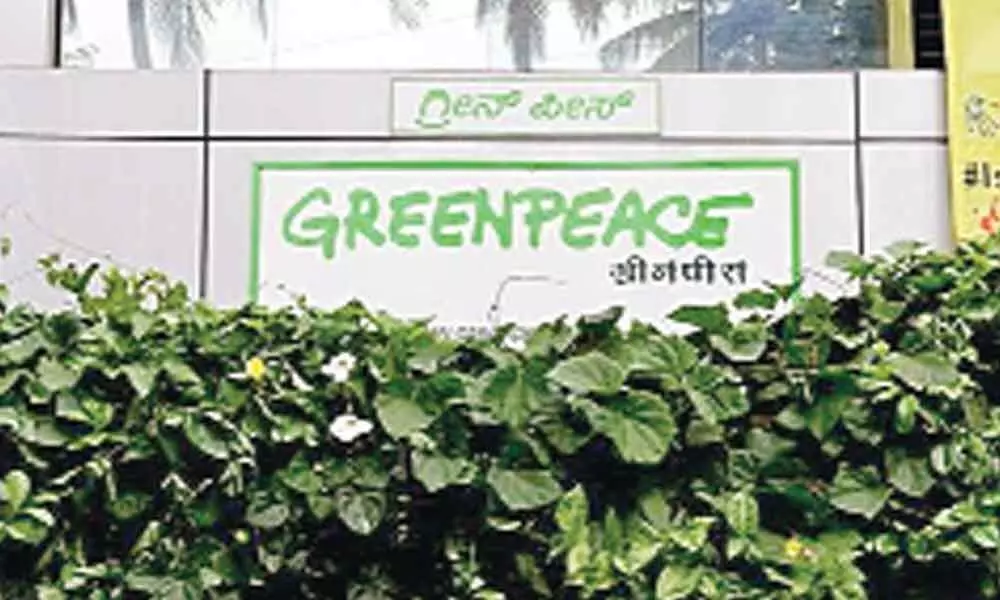Live
- Assam only state to see dip in road accidents: CM Sarma
- MP BJP to celebrate former PM Vajpayee's birth anniversary on Dec 25
- Christmas Eve 2024: Heartwarming Messages To Share With Your Loved Ones
- PM Modi holds brainstorming session with economists in run-up to Budget
- “Telangana Ready to Support AI Technologies That Drive Social Impact,” says Special Chief Secy, Jayesh Ranjan at Woxsen University’s Future Tech Summit 2024
- Hero Motosports Team Rally Announces Squad For Dakar Rally 2025
- Two Men Found Dead In Parked Caravan In Kerala
- Mandhana moves closer to top spot in ODI, T20I rankings
- IND vs AUS Boxing Day Test 2024: Sam Konstas Debuts, Travis Head’s Fitness in Question
- Congress Challenges Election Rule Amendments In Supreme Court
Just In
Air pollution in Delhi hasn't decreased, says Greenpeace


The Delhi government's claim of a 25 per cent reduction in air pollution levels over the past few years is not true, environment NGO Greenpeace India said on Thursday.
New Delhi : The Delhi government's claim of a 25 per cent reduction in air pollution levels over the past few years is not true, environment NGO Greenpeace India said on Thursday.
"Historical ambient air quality monitoring and satellite data coupled with increasing fossil fuel consumption in Delhi and adjoining states contradict the government's claims of a 25 per cent reduction in pollution levels over past years," according to an analysis by the NGO.
In government advertisements, Chief Minister Arvind Kejriwal has been claiming that levels of PM 2.5 (or particulate matters equal to smaller then 2.5 microns in diameter) reduced to an average of 115 between 2016 and 2018 from an average of 154 between 2012 and 2014, which amounted to a 25 per cent reduction.
However, Greenpeace India said that satellite data shows no statistically significant reduction in PM2.5 levels over the period from 2013 to 2018 and only shows slight reductions in later part of 2018 compared to the past three years.
Also, contrary to the claims of the AAP government that pollution has plummeted in the city, PM10 levels have augmented in 2018 as per the data at the manual air quality monitoring stations operated by pollution watchdog CPCB i.e. Central Pollution Control Board, the NGO said.
"PM10 data at manual air quality monitoring stations operated by CPCB under National Ambient Air Quality Monitoring Programme (NAMP) on the contrary shows higher PM10 levels in 2018 compared to 2013, 2014 and 2015," it said.
Greenpeace India and air visual report earlier in March this year declared Delhi to be the most polluted capital city in the world. Recently, the Delhi government and the Centre's Ministry for Environment initiated multiple discussions about improvements in air quality in Delhi with different data-sets.
"It is noticeable that Delhi and the two states, Haryana and Punjab, saw a rise in coal consumption by 17.8 per cent from 2015-16 to 2018-19. "On the other hand, total petroleum product consumption increased by 3.3 per cent over the same period, both contributing to increasing emissions and complicated clean air efforts," Greenpeace said.
Avinash Chanchal from Greenpeace India said the steps taken in mid 2018 by the Delhi and central governments to reduce pollution were not felt by the end of the year and would not be enough to provide breathable air quality.
"The actions which have been taken and implemented to reduce air pollution in Delhi be it the bypass roads, shutting down of Badarpur Power plants, shifting the industries to PNG and availability of BS-VI fuel were taken in mid/end 2018 and these steps along with others will surely result in reduction of pollution levels on an annual average basis.
But the majority of impacts of such steps collectively was not seen till the end of 2018 and these wouldn't be enough to provide breathable air quality," he said. He emphasised that the trends in PM10, PM2.5 and NO2 levels indicate that emissions from biomass burning (household and agricultural) were falling while emissions from fossil fuel burning are increasing in Delhi, Haryana and Punjab region.
"31 out of 33 coal fired electric generation units do not have even Fuel Gas Desulphurization (FGD) installed to reduce SO2 emissions as mandated by ministry of environment. These had to be installed by December 2017 initially and by December 2019 as per the second timeline given by Ministry of Power and environment ministry as submission to Supreme Court in an ongoing case.

© 2024 Hyderabad Media House Limited/The Hans India. All rights reserved. Powered by hocalwire.com






